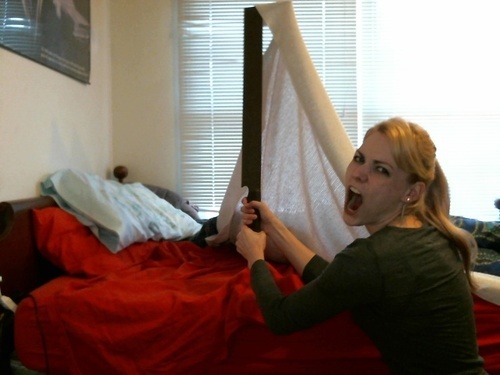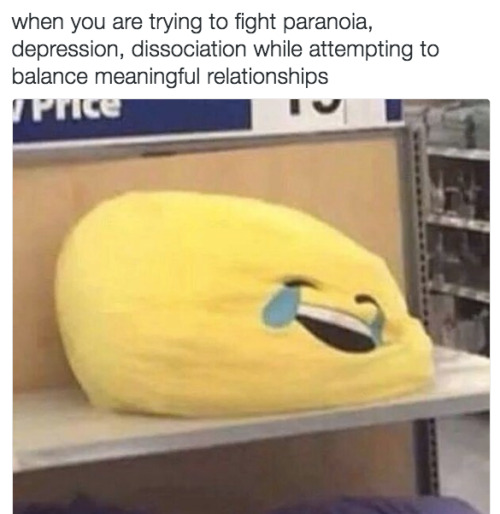“Give Him Some Demerol And/or Dilaudid. Three Of You Get 45 Minutes.”
“Give him some Demerol and/or Dilaudid. Three of you get 45 minutes.”
I wish I hadn’t been sedated, but at least I got some?

More Posts from Sordidsass-blog and Others
As many of you know, I recently purchased an Uruk-Hai scimitar.

Well let me tell you, it was quite the pragmatic purchase. It has endless uses in my morning routine.
Such as making the bed:

Making toast:

Getting things off high shelves:

Making coffee:

Reaching the remote when it’s too far away:

And assisting me when I ran out of toilet paper:

I don’t know how I survived life without it.













Watch: President Obama delivers pointedly feminist speech at United State of Women summit
How to Kill Feelings of Inadequacy
1. Choose to like, love, value, and believe in yourself. Choose to be your greatest allay – and the best friend you could have.
2. Ask a good friend if they’ll tell you what they like about you most. Then believe what they are saying – don’t just push their words aside.
3. Commit to discovering what you’re good at and enjoy, then invest time and energy on developing those traits.
4. Don’t exalt others’ gifts as if they matter more than yours. Every talent is important. Don’t right off your personal strengths.
5. Learn to show yourself compassion when you struggle or you fail. And remember “you are human” - so you’re going to make mistakes.
6. Notice ways that you are growing … ways you’re changing over time. Give yourself some credit for this – you are different from before.

If you study psychology, or know someone who does, could you request an invite to this exclusive group:https://www.facebook.com/groups/psych2go/
STPD summarized
StPD, or Schizotypal Personality Disorder, is a Cluster-A personality disorder.
The symptoms of STPD are as follows:
-Ideas of reference -Odd beliefs or magical thinking (In children and adolescents, bizarre preoccupations or fantasies) -Unusual perceptual experiences -Odd thinking and Speech -Suspiciousness or Paranoia -Inappropriate/Constricted Affect -Behavior/Appearance that is odd, peculiar, or eccentric -Few or no close friends/confidants -Excessive Social Anxiety that does not go away with familiarity
I’ll go over these symptoms in more detail later, but there they are!
Basically, STPD is like a very mild form of Schizophrenia. Those who have it are very detached from their peers, but not by choice–their separation is generally very painful for them, because they WANT to have close friends, but they don’t trust people enough to get very close.
They may also have mild psychotic symptoms–their ideas of reference and magical thinking resembling delusions, and odd perceptual experiences resembling (very mild) hallucinations. The difference, however, is that they can tell the difference between reality and fantasy. They will usually be able to tell that, realistically, no one is watching them and that the things they hear are just illusions. It’s still terrifying, though, and they’ll still feel very anxious and paranoid about it!
There are two subsets of STPD, which are timorous and insipid. Timorous schizotypals are more passive and fearful, and share some characteristics with AvPD. Insipid schizotypals are more withdrawn and indifferent, and share characteristics with SzPD. I’ll go over these more later, but that’s the gist of it.
Around 1-3% of the population has StPD, (which is the same statistic for people with red hair.) Very few people with StPD receive proper treatment, both because of the bias surrounding personality disorders and the disconnect between Schizotypals and themselves. People with STPD can’t often tell that they have a strange way of thinking until they consciously compare themselves with others. However, that doesn’t mean they will NEVER see their thinking as strange! Some schizotypals are aware of their own disorder, and some psychologists theorize that this is because their disorder stems from cognitive deficiencies rather than their environment or predisposition.
If you have any questions, feel free to ask!
Thanks for reading :)

The PTSD is strong in this one.




You should share this for people in DC and close to you!!
Black Community we have to be careful. Protect our Girls! Spread this!
TREAT YO SELF, 2015!
(First aired October 13, 2011)
-
 emodragon liked this · 3 years ago
emodragon liked this · 3 years ago -
 starrymoonsstuff liked this · 4 years ago
starrymoonsstuff liked this · 4 years ago -
 nemurian liked this · 4 years ago
nemurian liked this · 4 years ago -
 swallowtailcherry liked this · 5 years ago
swallowtailcherry liked this · 5 years ago -
 beyondtheherds liked this · 5 years ago
beyondtheherds liked this · 5 years ago -
 aidisgj reblogged this · 6 years ago
aidisgj reblogged this · 6 years ago -
 aidisgj liked this · 6 years ago
aidisgj liked this · 6 years ago -
 sweetness-4-you liked this · 6 years ago
sweetness-4-you liked this · 6 years ago -
 mediocre-savant reblogged this · 6 years ago
mediocre-savant reblogged this · 6 years ago -
 pinkandsuffering liked this · 6 years ago
pinkandsuffering liked this · 6 years ago -
 roseeleah liked this · 6 years ago
roseeleah liked this · 6 years ago -
 fluffydonuts22 liked this · 7 years ago
fluffydonuts22 liked this · 7 years ago -
 bigoufmemes liked this · 7 years ago
bigoufmemes liked this · 7 years ago -
 mizumonospace reblogged this · 7 years ago
mizumonospace reblogged this · 7 years ago -
 mizumonospace liked this · 7 years ago
mizumonospace liked this · 7 years ago -
 chlo3luvcats-blog liked this · 8 years ago
chlo3luvcats-blog liked this · 8 years ago -
 prissi37 liked this · 8 years ago
prissi37 liked this · 8 years ago -
 eremin4thewin reblogged this · 8 years ago
eremin4thewin reblogged this · 8 years ago -
 otakorn-blog reblogged this · 8 years ago
otakorn-blog reblogged this · 8 years ago -
 otakorn-blog liked this · 8 years ago
otakorn-blog liked this · 8 years ago -
 ntwarrior liked this · 8 years ago
ntwarrior liked this · 8 years ago -
 stayawayforgodsake liked this · 8 years ago
stayawayforgodsake liked this · 8 years ago -
 whyarceuswhy reblogged this · 8 years ago
whyarceuswhy reblogged this · 8 years ago -
 whyarceuswhy liked this · 8 years ago
whyarceuswhy liked this · 8 years ago -
 crimsonmoon0w0 reblogged this · 8 years ago
crimsonmoon0w0 reblogged this · 8 years ago -
 themagnoliaprince reblogged this · 8 years ago
themagnoliaprince reblogged this · 8 years ago -
 queeniestqueer-addicted2eremin reblogged this · 8 years ago
queeniestqueer-addicted2eremin reblogged this · 8 years ago -
 queeniestqueer-addicted2eremin liked this · 8 years ago
queeniestqueer-addicted2eremin liked this · 8 years ago -
 clee-aou-blog liked this · 8 years ago
clee-aou-blog liked this · 8 years ago -
 kittydemon liked this · 8 years ago
kittydemon liked this · 8 years ago -
 freshestsquidspost reblogged this · 8 years ago
freshestsquidspost reblogged this · 8 years ago -
 nilechile reblogged this · 8 years ago
nilechile reblogged this · 8 years ago -
 kaiarrase liked this · 8 years ago
kaiarrase liked this · 8 years ago -
 justshipping007-blog liked this · 8 years ago
justshipping007-blog liked this · 8 years ago -
 lannaanabannana liked this · 8 years ago
lannaanabannana liked this · 8 years ago -
 fuerimmerbegraben reblogged this · 8 years ago
fuerimmerbegraben reblogged this · 8 years ago
Struggling with mental illness after a traumatic event most likely caused by mental illness. Sexual Assault Survivor.
282 posts